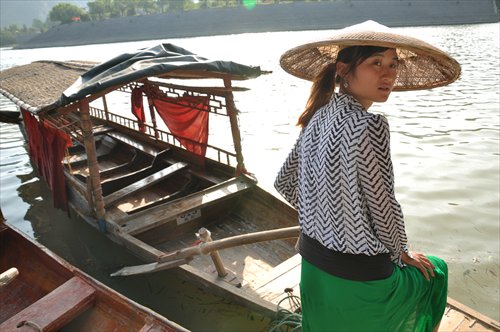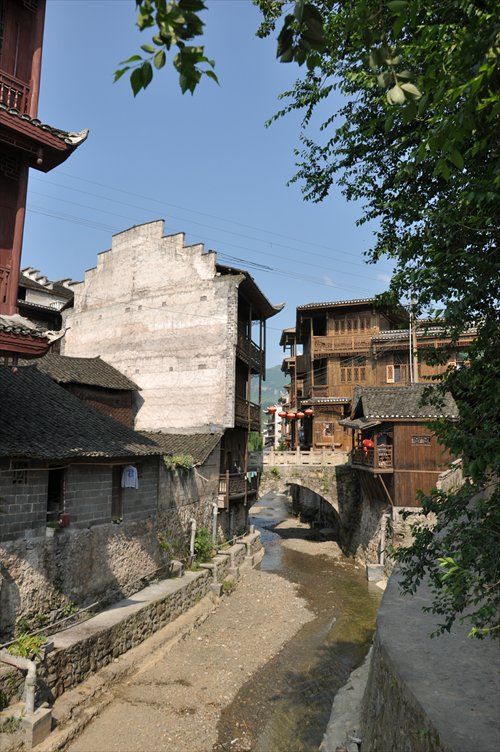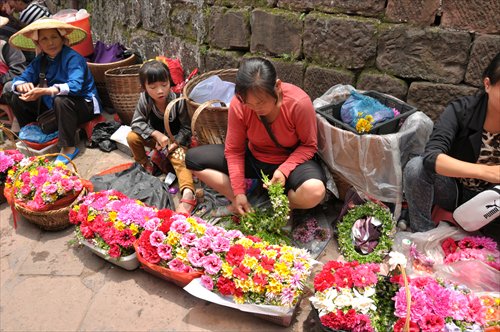Picturesque Xiangxi
Mountain hideaways steeped in tradition and beauty await travelers
Located in a mountainous area of western Hunan Province, the Xiangxi Tujia and Miao Autonomous Prefecture (Xiangxi for short) is an ideal winter getaway destination.
Xiangxi's breathtaking and unique landscape surprises its visitors whatever the season. Crystal clear rivers wind through the rugged forested mountains, where several small towns and villages are sporadically tucked away. Most of these are homes to the Tujia and Miao ethnic groups, which have been there for thousands of years.
Even today, local people still live a primitive rural life, and many of them, old folks in particular, know little about the world outside. They keep their plain ethnic customs and vibrant culture, which are attractive to city dwellers.

The mountainous Xiangxi Tujia and Miao Autonomous Prefecture in western Hunan Province is an ideal winter getaway destination. Photos: Huang Lanlan/GT
Phoenix ancient town
Hidden deep in the high mountain ranges of southwestern Xiangxi, the Phoenix ancient town, got its name from a mountain that looks like a flying phoenix.
Rewi Alley, a renowned writer from New Zealand, once described it as the most beautiful town in China. In the mornings, when the small town awakes to the sounds of birds chirping in the trees, and women washing clothes by the Tuo River, its lanes and houses are bathed in the soft morning light.
Houses along the Tuo River are quite different from those in the water towns of suburban Shanghai. They are called diaojiaolou, meaning stilted wooden houses standing over the water. Usually seen in Xiangxi and some mountain areas of Guizhou Province, diaojiaolou are a typical type of dwelling for the local ethnic groups.
The town becomes lively when the sky lightens and the sun rises higher. Many shops open, some of which sell freshly made ginger candies.
Made with ginger juice and brown sugar, the candy is a popular local snack. The air becomes sweet with the smell of ginger as dozens of snack makers become busy with their work.

Later, some Miao people wearing bright-colored ethnic folk costumes propel their small wooden boats on the Tuo River by long poles. The boats slowly glide along the river, and people on the boats loudly sing folk songs - most of which are beautiful love songs.
In the evenings, once the sky has turned black, the small town turns into a world of bars and pubs where young tourists get together and party while the clear Tuo River, reflects the colorful lights along the riverbank.

Dehang Miao village
The word dehang in the Miao language, means "a beautiful canyon." Located 24 kilometers west of Jishou, the village lies in the deep mountains of the Yunnan-Guizhou Plateau and is a 2-hour tourist bus ride away from the Phoenix ancient town.
As home to some 100 Miao families, the village is mainly famous for its picturesque landscape, including hundreds of old wooden diaojiaolou and surrounding mountains, cliffs, waterfalls and verdant forests, which turn the small village into a scene from an elegant watercolor painting.
Another draw for tourists is the way the local Miao people celebrate their festivals.

The Miao New Year, for example, is celebrated between late autumn and late winter in accordance with different branches of the Miao minority.
On the day of the festival, the old and quiet village is enlivened by its residents who put on their vivid-colored costumes, drink, sing, dance and play the drums and lusheng - a kind of reed pipe wind instrument.
For those who go to the village at other times, there is no need to worry about missing the chance of experiencing local folk customs and culture.
After the local government turned it into a tourist attraction years ago, every day the village holds various traditional Miao folk activities that visitors can watch and take part in, such as Miao-style weddings and parties.
Dehang village is also far less known among tourists than the Phoenix town, meaning it is still possible to enjoy an interesting and relaxed holiday largely untouched by floods of tourists.

Biancheng town
Biancheng town, literally "border town" in Chinese, is situated at the juncture of Chongqing and Hunan and Guizhou provinces.
The small, remote town deep in the mountains was popularized in the 20th century by the late eminent Chinese writer Shen Congwen's novel The Border Town, which was set there. A film adaptation of the model was also popular.
The novel tells a love story that took place in the cloistered town in the 1930s, when a beautiful and innocent teenage girl named Cuicui fell in love with a handsome young sailor named Nuosong.
Today, strolling around the town, people can find a small island in the middle of the Qingshui River. Locals named it Cuicui Island, and built a sculpture of the girl Cuicui on it in the early 2000s.
When the color of the sky deepens as the sun goes down, visitors can take a small bamboo-made boat to the island that is covered with evergreen plants. There are no shops and dwellings on the island, but numerous subtropical trees and flowers.
The island is the perfect spot to relax among nature and forget the troubles of the city.